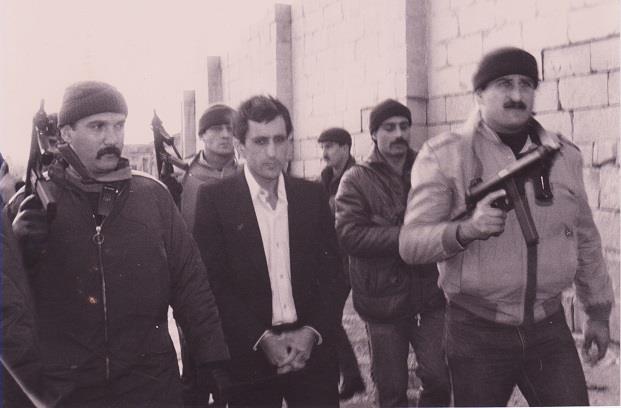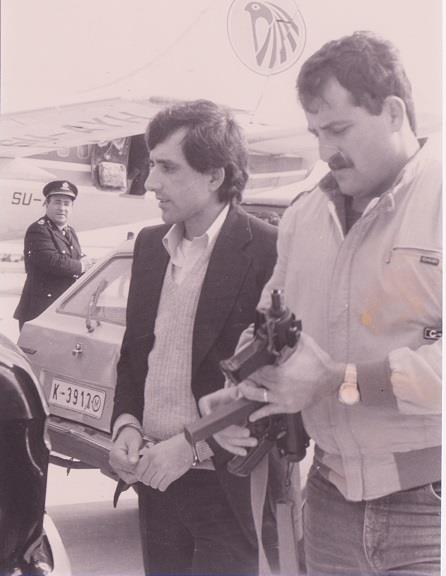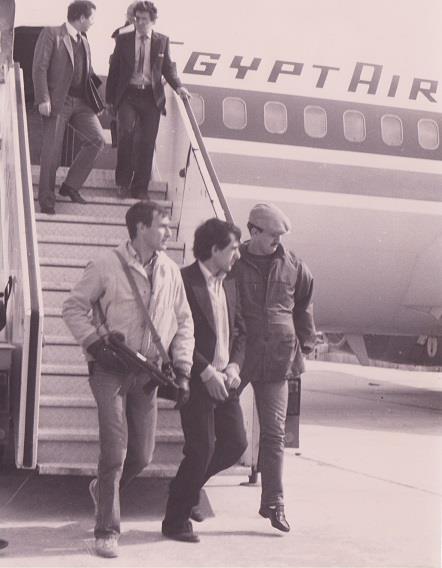Thousands of flights leave airports across Europe every day, and connect with their destinations with no problem at all. 95 out of the 98 people onboard EgyptAir flight 648 had no reason to think that anything other than that would happen when their flight took off from Athens in Greece to go to Cairo in Egypt on the evening of 23 November 1985.
Ten minutes into the flight, however, that all changed and what followed in the next 24 hours or so would be one of the most dramatic, and fatal, episodes of air piracy to date.
A dramatic hijacking
As the aircraft rose to its cruising height of 33,000 feet, Omar Mohammed Ali Rezaq, Nar Al-Din Bou Said, and Salem Chakore, got out of their seats and took over the aircraft. Ali Rezaq immediately went into the cockpit, Bou Said sat towards the back of the aircraft, and Chakore – the leader – took to the front of the aircraft.
Chakore immediately went about calling the 89 passengers forward, frisking them, and sorting them according to their nationalities. Two Israelis – Tamar Artzi and Nitzan Mendelson – were placed at the front of the aircraft, with the three Americans on the flight – Patrick Scott Baker, Scarlett Robenkamp, and Jackie Nink Pflug – sat behind them.
The rest were sat further back. 11 Palestinians – deemed by the hijackers to be of no security threat whatsoever to them owing to the fact that they too were Palestinians – were placed at the far back of the aircraft. They were mostly women and children.
What the hijackers did not know was that amongst the passengers were four sky marshals. One of them – Mustafa Medhat Kamal – fearing that he would be caught out as a marshal, grabbed his gun from the seat pocket in front of him and opened fire. He managed to kill the hijackers’ ring-leader Chakore, but was subsequently shot in the back by Bou Said – at which point he fell to the floor, seemingly dead.

Hijacker Ali Rezaq, handcuffed, being escorted after the hijack (All photos - DOI)
In the commotion, 19 shots were fired. Medhat’s gun was loaded with 9mm hollow-point bullets – lethal at close range, but purpose built in order not to puncture the aircraft’s fuselage if used. The same cannot be said for the Webley revolvers used by the hijackers. Two of the shots pierced the aircraft’s cabin, leading to a loss of compression.
Faced with this, the captain of the aircraft – Hani Galal – was left with no choice but to take the aircraft down to below 10,000 feet due to the lack of oxygen at its cruising altitude. At this height, much more fuel is burned, leaving the captain fearing that he would not be able to make it to wherever the hijackers wanted to go.
After Chakore’s death, Ali Rezaq took control of the situation. While their first intended destination was Algeria, he asked the captain to fly to Libya, however was told that the aircraft did not have enough fuel to do that. Sigonella – a US-airbase in Sicily – was suggested as a destination instead. This was, perhaps unsurprisingly, rejected. Ali Rezaq eventually demanded that the aircraft be flown to Malta.
Malta initially did not want the aircraft to land there; it was only when captain Galal told the control tower that the choice was between allowing them to land, or him ditching the aircraft at sea that they were granted permission to land and taxi to Park 4.

‘I will kill someone every 15 minutes’
Interviewed by The Malta Independent on Sunday, forensic investigator Anthony Abela Medici recalls that he and his team were at the wedding of one of their colleagues when they received a call telling them that there had been a hijack and that they had to be on standby.
Abela Medici was the head of the police’s forensics team, and was joined within that team by two scene of crime officers: PC4 John Charles Ellul and PC256 Charles Aquilina.
Sure enough, as the drama unfolded at Luqa airport, their attendance at the wedding was cut short soon after.
As soon as the Boeing 737 touched down, it was surrounded by Maltese army personnel and negotiations began, with Ali Rezaq conversing directly with Prime Minister of the time Karmenu Mifsud Bonnici.
Ali Rezaq demanded food and fuel for the aircraft to be able to take-off. Food was promised, but only on the condition that the female passengers onboard the aircraft are released. Ali Rezaq agreed, but only on the condition that a doctor is sent onboard to examine his fallen colleague Chakore.
The Maltese agreed, and junior doctor Victor Buhagiar was sent onto the plane. He examined Chakore and confirmed that the hijacker was indeed deceased. Seeing another body – that of the sky marshal Medhat – he offered to examine him too. After some hesitation, Ali Rezaq agreed.

Medhat’s body was removed from the aircraft, and for good reason too – he was still alive. Abela Medici explains that it turned out that he had suffered only a superficial wound to his back, because Bou Said’s weapon was defective. Him playing dead for the duration of the flight had saved his life.
Meanwhile, Ali Rezaq called 16 Filipino women – who formed part of a dance troupe together – and 16 Egyptian women, and slowly released them from the aircraft.
He then called the first Israeli – Tamar Artzi. Abela Medici says that Artzi, having seen 32 women be released, got up with a sense of near nonchalance, thinking that she too would be released. She got to the passenger steps, at which point Ali Rezaq behind her raised his pistol and shot her.
However, Artzi had made a movement which resulted in her only being grazed by the bullet. She fell to the floor, as if she was dead, and Ali Rezaq threw her down the stairs, where she remained motionless.
The hijacker had told the Maltese in the control tower that he would kill a person every 15 minutes until his demands for fuel are met.
Sure enough, 15 minutes later, he called Nitzan Mendelson to the stairs. “She had just seen her friend being shot. She went up as if she was a sheep going for slaughter”, Abela Medici recalls. Mendelson was shot in the head by Ali Rezaq, and thrown down the steps onto Artzi.
At this point, Artzi moved slightly. Ali Rezaq ran down the stairs and shot her again, this time in the pelvis.

The aircraft's captain - Hani Galil - led off the aircraft after the attack.
Patrick Scott Baker, the first American, was then shot, followed by Scarlett Robenkamp.
By this point, Artzi had ran under the aircraft, where she met army captain Leo Borg who took her to the control tower and then to hospital. Artzi would survive the ordeal, as would Baker. Mendelson died at St. Luke’s Hospital a week later, while Robenkamp died upon being shot.
The following morning, Jackie Nink Pflug was shot in the head by Ali Rezaq and thrown down the stairs. She was there for the best part of five hours before being picked up by disguised police officers when food was being delivered to the aircraft. She too survived, with the bullet lodged in her brain.
Abela Medici meanwhile had been appointed by then Health Minister Vincent Moran to lead the doctors at the hospital and to take statements from the passengers and the injured at St. Luke’s Hospital.
Indeed, from that afternoon he recalls how the Israeli consul had gone to the hospital to speak to Artzi. He agreed to allow this as long as the consul spoke in English. When Artzi understood whom she was speaking to, Abela Medici recalls, she immediately breathed a sigh of relief: she thought that the aircraft had landed in an Arab country, which would have been a very dangerous place for her as an Israeli. She had in fact initially given the Maltese a fake American name instead of her real one, precisely due to this fear.
At around 7pm that evening – just under 24 hours after the flight had left Athens – Abela Medici along with his driver decided to go to Luqa to see what was happening.
It was as they approached the airport that chatter was picked up on the police radio. Abela Medici recalls: “I started hearing shooting, shouting, and screaming. The Egyptians had attacked.”

The arrival of the Egyptians
While the drama had been unfolding on the apron, there had been further drama in the control room throughout the day.
Prime Minister Karmenu Mifsud Bonnici was hesitant to allow American or Israeli forces to take over the situation, fearing that doing so would impinge on Malta’s status of neutrality.
A CIA intelligence report from the 24 November, as the situation was still unfolding, in fact states how the Maltese government was becoming “increasingly sensitive to suggestions from US officials that Malta could become a transit point or target for Libyan inspired terrorism.”
“Maltese officials have expressed concern over US warning that they could find themselves accused of guilt by association”, the report reads.
Under mounting pressure, the Prime Minister was told of the possibility of a US-trained Egyptian special forces team being flown in to handle the extraction of the hostage and the killing of the hijackers. He ultimately opted for that avenue and continued to try and buy time until the team could arrive.
It had been agreed that the attack would take place the following morning when food was to be taken to the aircraft.
However, at around 8pm, the lights around the aircraft went off, a powerful explosion breached the aircraft and the Egyptians attacked.
Speaking to the Times of Malta a decade ago, then Tourism Minister the late Joe Grima, who was in the control tower, said that the Prime Minister’s first words as the scene unfolded before them was “they fooled us.”

The bloodbath that unfolded
Discussing the findings of the forensic analysis, Abela Medici says that the Egyptians had used 2kg of Semtex to breach the aircraft. The explosives were placed in the aircraft’s hold, right under the seat one of the hijackers – Bou Said – was sitting.
“They didn’t need to use that amount of explosives. In the process, because it was a windy day, the explosion fueled a fire which took over the fuselage and moved along the top set the overhead compartments of the cabin alight as well. This let out extremely toxic fumes inside the localized area of the cabin. 54 people were intoxicated by the fumes”, he explains.
He continues, explaining that the Egyptians had mounted each wing and opened fire at the inside of the aircraft. The analysis of his team found that 92 bullets had been fired. Four people – including two passengers who had tried to escape the aircraft when the commotion began – were shot dead by the soldiers. Even the aircraft’s co-pilot, who had jumped out of the cockpit in an attempt to flee was shot at by Egyptian snipers mounted at the control tower, Abela Medici says.
The two-minute ordeal was a bloodbath.
Omar Mohammed Ali Rezaq, however, was not one of the fatalities.
When the hijacker saw what was unfolding, he had tried to make his escape via the front of the aircraft. He was however faced with four soldiers coming up towards him. He threw hand grenade, which blew up at the foot of the stairs, injuring all four of the soldiers – one of them subsequently had to have both legs amputated.
He then took his mask off, and acted as if he was a passenger. Seriously injured, he was taken along with other passengers to St. Luke’s Hospital.

‘The man in the grey trousers’
By now, Abela Medici had returned to St. Luke’s Hospital. He recalls how when the hospital bus with the injured arrived, four men in civilian clothing jumped out, grenades in hand, threatening to blow up the ITU ward in the hospital.
Eventually, with the help of a policeman who knew Arabic, the men – who were Egyptian soldiers – were calmed and told to lay down their arms, which were subsequently locked in the hospital’s porter’s lodge.
They were in fact looking for Ali Rezaq, after it had now become evident that he had evaded their clutches on the plane. It was, however, to no avail – Ali Rezaq was already in the operating theatre by then.
Tonio Attard, a staff nurse within ITU at the time, remembers every minute of that night. Speaking to The Malta Independent on Sunday he recalls how it was a “Babylon of languages” within ITU.
He remembers Ali Rezaq vividly – although at the time, he did not know that the man was in fact the hijacker.
“We identified him at the time simply as ‘the man in grey trousers.’ He was wearing grey trousers at the time and I remember us removing them so that we could put the gown on before he was operated. We didn’t know who he was – we didn’t even know that he was the hijacker”, Attard recalls.

The most fatal episode in Malta’s peace-time history
Meanwhile, the following day, investigations on the aircraft began. Statements were taken, and all eventualities were investigated. One such claim that the captain of the aircraft had attacked a hijacker with an axe, a claim which was widely reported in international media, was later proven to be untrue.
Firefighters meanwhile began to remove the bodies one by one, placing them in a hangar at the airport. The next day, relatives of those thought to have died began to be flown in.
“The first to arrive was this old, big woman, who arrived with a Greek army doctor. She started going round the mortuary with the doctor, and I remember – I can see her in front of my eyes even now – that when she got to the end of the hangar, she started shouting, screaming, and pulling her hair. She saw her son, dead, in front of her”, Abela Medici recalls.
In all, 60 people had perished.
Amongst them were Greek sailors, a Mexican actress, two heavily pregnant women, and a 10-year-old boy who was shot in his seat by the attacking soldiers.
The investigation took six months, with the forensic report being so comprehensive that it even attracted praise from the American ambassador, who told Abela Medici that not even from the FBI had he ever seen such a detailed report.
Ali Rezaq was charged and sentenced in a trial which happened at Fort St. Elmo to 25 years in prison. He was released after seven years.
He was re-arrested in Nigeria soon after his release, and extradited to the United States, where he faced a single charge of air piracy. He was sentenced to life in prison, and continues to serve his sentence in a prison in Illinois.
Up until September 11, 2001, EgyptAir Flight 648 was the most fatal hijacking of an aircraft, and it remains the most fatal episode in Malta’s peace-time history.
All photos credited to the Department of Information (DOI)